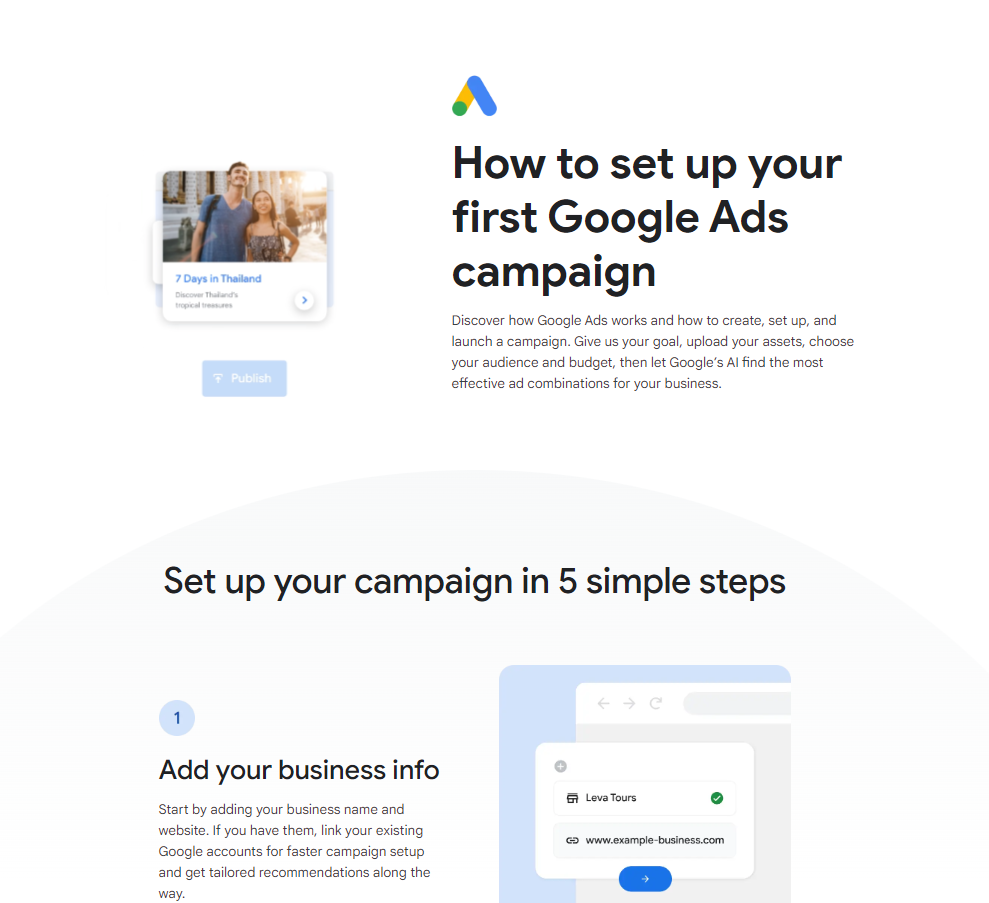October 10, 2024
Google AdSense Mastery: Expert Tips for Success

Greg Kopyltsov
Founder
account adsense
GoogleAdsense


Google AdSense is a powerful online advertising program that allows website publishers to monetize their content and generate revenue. With Google's vast network of advertisers and advanced AI technology, AdSense revolutionized the way online advertising works. In this blog, we will explore the key aspects of Google AdSense and provide expert tips to help you achieve success with the program.
Google AdSense is an online advertising program developed by Google. It enables website publishers to serve text, image, video, or interactive media advertisements that are targeted to the site's content and audience. These advertisements are administered, sorted, and maintained by Google, and publishers can earn revenue on a per-click or per-impression basis. AdSense uses Google's technology to serve ads based on website content, user location, and other factors. It has become one of the most popular programs for creating and placing ads on websites and blogs, providing a significant source of revenue for many publishers. Understanding Google AdSense and how it works with site content is essential for success in utilizing this program.
Google AdSense was launched by Google in June 2003, marking a significant milestone in the evolution of online advertising. With the rise of the internet, businesses were looking for effective ways to reach their target audience and promote their products or services. Google AdSense provided a solution by allowing website publishers to earn revenue by displaying relevant ads on their sites, similar to how Google displays ads in its search results. Over the years, Google has continuously improved and expanded the AdSense program, incorporating advanced AI technology to optimize ad placement and increase ad relevance. Today, AdSense is a trusted and widely used platform for online advertising, helping publishers monetize their content and advertisers reach their target audience effectively.
Google AdSense revolutionized online advertising by introducing advanced features and technologies that transformed the way ads are displayed and targeted. With the help of Google's AI technology, AdSense can analyze website content and user behavior to deliver highly relevant ads. This not only benefits advertisers by ensuring their ads are shown to the right audience but also improves the user experience by displaying ads that are more likely to be of interest to the user. AdSense also offers various ad formats and sizes to match the design and layout of different websites, making it seamless for publishers to integrate ads into their content. This level of customization and optimization, powered by Google AI, has significantly increased the effectiveness and efficiency of online advertising, making AdSense a preferred choice for publishers and advertisers worldwide.
Setting up a Google AdSense account is a straightforward process that involves a few simple steps. Before you begin, make sure you have a website or blog where you intend to display the ads. You will also need a Google account to access the AdSense program. Start by visiting the AdSense website and signing in with your Google account. From there, you can follow the step-by-step guide provided by Google to create your AdSense account. It is essential to read and understand the terms of service and policies outlined by AdSense to ensure compliance and avoid any potential issues in the future.
Creating an AdSense account is a simple process that can be done by following these steps:
It is important to note that the approval process may take some time, as Google reviews each application to ensure compliance with their policies. During this time, you can familiarize yourself with the AdSense program and explore the various features and options available to optimize your ad revenue.
Getting your AdSense account approved requires careful consideration of the following tips:
By following these tips, you increase your chances of getting your AdSense account approved and setting yourself up for success in monetizing your website's traffic.
Optimizing your website for AdSense involves implementing best practices to maximize your ad revenue. This includes optimizing ad placement, creating high-quality and relevant content, and ensuring compliance with AdSense policies. By optimizing your website for AdSense, you can attract more advertisers, increase ad visibility, and ultimately generate higher revenue.
Designing your website with user experience and ad placement in mind is crucial for maximizing your AdSense revenue. Consider the following best practices:
By following these best practices, you can create a website that not only provides a great user experience but also maximizes your AdSense revenue through effective ad placement.
Creating high-quality and relevant content is essential for attracting high-paying ads on your website. Consider the following content strategies:
By implementing these content strategies, you can attract high-paying ads that are relevant to your audience and increase your AdSense earnings.
Strategic ad placement is key to maximizing your earnings with AdSense. By understanding ad placement policies, CPC rates, and utilizing various ad formats and sizes, you can optimize your ad revenue.
To maximize the visibility and effectiveness of your ads, consider the following placement strategies:
By strategically placing your ads, you can increase their visibility and engagement, leading to higher earnings with AdSense.
AdSense offers a variety of ad formats and sizes to cater to different types of websites and user experiences. Understanding these formats and sizes is crucial for maximizing your AdSense earnings. Some popular ad formats include:
By experimenting with different ad formats and sizes, you can find the ones that work best for your website and audience, ultimately maximizing your AdSense earnings.
Once you have optimized your website for AdSense and implemented best practices, you can explore advanced strategies to further maximize your earnings.
Custom channels are a powerful tool in the Google AdSense program that allows publishers to gain detailed insights into their ad performance. By creating custom channels, publishers can track the performance of specific ad units, ad sizes, or placements on their website. This information can help them identify which ads are generating the most revenue and optimize their ad strategy accordingly.
Custom channels can also be used to compare the performance of different ad formats or placements. For example, publishers can create separate channels for ads placed in the header, sidebar, or within the content of their website. By analyzing the data from these channels, publishers can determine which placements are most effective and make informed decisions on how to maximize their revenue.
To set up custom channels, publishers can use the Ad Manager tool provided by Google. Ad Manager allows users to create and manage custom channels, as well as track the performance of individual ads and ad units. By leveraging custom channels and utilizing the insights gained, publishers can optimize their AdSense revenue and enhance their overall ad strategy through the Google Ads mobile app and other resources provided by Google.
While AdSense offers a great opportunity for publishers to monetize their websites, there are some common mistakes that should be avoided. Violating the AdSense terms of service can result in account suspension or termination, so it's important to familiarize yourself with the guidelines and adhere to them. Some common mistakes include engaging in invalid click activity, such as clicking on your own ads or encouraging others to do so. It's also crucial to comply with ad placement policies, which dictate where ads can and cannot be placed on your website. By avoiding these mistakes, publishers can ensure a successful and sustainable AdSense partnership.
AdSense has strict policies in place to ensure a high-quality user experience and fair competition among advertisers. Violating these policies can result in serious consequences, including the suspension or banning of your AdSense account. Some common violations include engaging in click fraud, encouraging clicks on your ads, placing ads on prohibited content, displaying excessive ads on a single page, and using affiliate programs that violate AdSense policies.
It's important to familiarize yourself with the AdSense terms of service and policies to avoid unintentional violations. Regularly reviewing your website's content and ad placement can help ensure compliance. If you receive a warning or notice of policy violations from AdSense, take immediate action to rectify the issue and prevent further violations.
By adhering to the AdSense policies and guidelines, publishers can maintain a healthy and successful partnership with Google and avoid the risk of having their AdSense account banned.
Invalid click activity refers to any clicks on AdSense ads that are generated artificially or in violation of the program policies. This could include clicking on your own ads, encouraging others to click on your ads, or using automated tools to generate clicks. Invalid click activity is strictly prohibited by AdSense and can result in account suspension or termination.
If you suspect that there is invalid click activity on your ads, it's important to report it to the AdSense program. You can do this through the AdSense Help Center, where you will find resources and instructions on how to report invalid click activity.
The AdSense program has measures in place to detect and prevent invalid click activity, but reporting any suspicious activity can help them take appropriate action. By working with the AdSense program and following their guidelines, publishers can ensure a fair and transparent ad ecosystem.
KeywordSearch has an AI Audience builder that helps you create the best ad audiences for YouTube & Google ads in seconds. In a just a few clicks, our AI algorithm analyzes your business, audience data, uncovers hidden patterns, and identifies the most relevant and high-performing audiences for your Google & YouTube Ad campaigns.
You can also use KeywordSearch to Discover the Best Keywords to rank your YouTube Videos, Websites with SEO & Even Discover Keywords for Google & YouTube Ads.
If you’re looking to SuperCharge Your Ad Audiences with AI - Sign up for KeywordSearch.com for a 5 Day Free Trial Today!
Mastering Google AdSense requires a deep understanding of its evolution, strategic setup, optimization techniques, and advanced strategies. By following best practices in website design, content creation, and ad placement, you can maximize your earnings potential. Avoid common mistakes to maintain account integrity and leverage performance reports for continuous improvement. Stay informed about AdSense policies and keep up with industry updates to ensure sustained success. With proper knowledge and implementation, Google AdSense can be a lucrative revenue stream for your online endeavors.
The amount you can earn with AdSense varies greatly depending on factors such as your website's niche, traffic volume, and the competitiveness of the ads displayed. While some publishers earn significant revenue from AdSense, others may earn only a modest amount. Earnings are typically calculated based on a cost-per-click (CPC) model, where you receive a portion of the revenue generated by clicks on your ads. To maximize your earnings, focus on building high-quality content, attracting relevant traffic, and optimizing your ad placements.
Yes, you can use AdSense on multiple websites as long as you comply with the program's terms of service. Each website must be approved individually, and you must ensure that the ads are placed in accordance with the ad placement policies. Keep in mind that the performance of AdSense ads may vary across different websites, so it's important to monitor and optimize each site separately.
If your AdSense account gets suspended, it's essential to review the suspension notice and the terms of service to understand the reason for the suspension. You can then take the necessary steps to rectify the issue and appeal the suspension if appropriate. The AdSense Help Center provides resources and instructions on how to appeal a suspension. It's important to address any policy violations to ensure a successful reinstatement of your AdSense account.